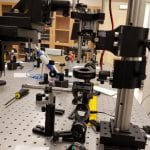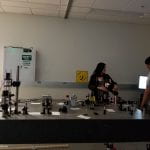Optical Micromanipulation Group
Optical tweezers, the trapping and manipulating of tiny objects, uses the momentum carried in shaped laser beams to explore the effects of light on matter. This way of controlling objects without physically touching them is used in a great variety of contexts such as stretching cells to learn about cell membranes, pushing nanospheres through constricted flow areas such as blood vessels, rotating asymmetric objects, and creating an entire “lab on a chip” where light makes many functions occur in a tiny area [1, 2]. Our Optical Micromanipulation Group explores the physics in this interplay between light and matter.
Polarization effects on birefringent particles
Modes carrying defined polarization (vector modes) offer a valuable parameter with which to manipulate materials, particularly those which are optically birefringent. The learning that can occur through activating birefringent materials or using those materials to shed light on polarization is unlimited. Recent examples exploring this interaction include investigations into the structure of mollusk nacre, spinning liquid crystals, and measuring polarization with calcite rotation. We examine the rotation of calcite crystals in polarized light with the goal of developing a way of moving more than one crystal (having multiple activities on the same “chip”) in the same focused laser beam.
The unique behavior of calcite we show here offers multiple avenues for manipulation. We have seen that perfect rhombohedrons of calcite position themselves in an optical trap such that the optical axis is along the beam propagation direction (beam axis). In this position, when illuminated with shaped laser light, they rotate in an unusually non-uniform way. The torque on calcite crystals in an optical trap changes dramatically depending on the crystal position. The two ways that light affects calcite crystals are due to its internal crystal structure and to its unusual asymmetric shape. Both of these contributing factors have been explored in detail. Rotation rates of birefringent objects in polarized light depend on the ellipticity and orientation of the polarization, and shape-birefringent objects (cylinders, rods) have an aspect-ratio-dependent orientation. When calcite is positioned with its optic axis along the beam axis, more than one ordinary and extraordinary refractive index directions affect the motion, and the crystal moves with a surprising sequence of rotational speeds. We illustrate this behavior through video image analysis and model the orientation-dependent torque.
Related publications
(Undergraduate students listed in bold)
Equilibrium positions of optically-trapped single-crystal uniaxial calcite
Elaina M. Wahmann, Catherine M. Herne
Optical Engineering 63(2), 025103 (2024), doi: 10.1117/1.OE.63.2.025103.
Polarization-dependent non-uniform rotation rates of rhombohedral calcite
Catherine M. Herne, Johanna R. Levey, and Tom R. McCausland
https://www.osapublishing.org/oe/abstract.cfm?uri=oe-27-13-18445
Determining elliptical polarization of light from rotation of calcite crystals
Catherine M. Herne, Natalie A. Cartwright, and Matthew T. Cattani
https://www.osapublishing.org/oe/abstract.cfm?uri=oe-25-9-10044
Rotation of matter with vortex modes
We show the manipulation and rotation of opaque graphite through adhesion with optically trapped polystyrene spheres. The absorbing graphite is rotated by the orbital angular momentum transfer from a Laguerre–Gauss laser mode and is trapped due to the presence of refracting spheres. This technique is effective for trapping and rotating absorbing objects of all sizes, including those larger than the laser mode.
Undergraduate Advanced Physics Lab Instruction
Conferences
Herne, Catherine M., “Development of Self-Efficacy in an Advanced Physics Lab”, American Association of Physics Teachers Summer Meeting, Sacramento, CA, July 2023.
Herne, Catherine M., “Building Student Self-Efficacy in Advanced Physics Labs”, American Association of Physics Teachers Summer Meeting, Grand Rapids, MI, July 2022.
Waldo, Jennifer T., Herne, Catherine M., “Expanding Inclusion: How a Program Supporting STEM Students Also Positively Impacts Faculty,” SUNY Diversity Conference, Albany, NY, December 2019.
Herne, Catherine M., Bodnar, Brian, “The Effectiveness of Student Diagramming for Self-Reflection,” American Association of Physics Teachers Summer Meeting, Provo, UT, July 2019.
Herne, Catherine M., “Reflective writing in the science laboratory,” SUNY Professional Development Conference, New Paltz, NY, April 2019.
Herne, Catherine M., Waldo, Jennifer T., Pandya, Raj, “Teaching inclusively in the science classroom,” SUNY Professional Development Conference, New Paltz, NY, April 2019.
Herne, Catherine M., “Predict, test, reflect: surprising learning through lab notebooks,” American Association of Physics Teachers Summer Meeting, Washington, D.C., 2018.
Related publications
Rotation of large asymmetrical absorbing objects by Laguerre–Gauss beams
Catherine M. Herne, Kristina M. Capuzzi, Emily Sobel, and Ryan T. Kropas
https://www.osapublishing.org/ol/abstract.cfm?uri=ol-40-17-4026
Conference Proceedings
O’Connor, Claire E., Sheneman, Allyson C., Herne, Catherine M., “Measuring attachment rate of predatory bacteria to prey,” Optical Trapping and Optical Micromanipulation XX, (2023).
Herne, Catherine M., “Birefringence and polarization experiments using calcite crystals in optical tweezers,” Conference on Labs Beyond the First Year, Chico, CA, July 2023.
Herne, Catherine M., Smithing, Carrie J., Hartman, Max T., Ferguson, Megan A., “Measuring bacterial attachment forces,” Optical Trapping and Optical Micromanipulation XVIII, 1179807 (2021).
Herne, Catherine M., Lyons, Faye E., Galvez, Enrique J., Sam, Akza, “Polarimetry studies on birefringent materials in optical tweezers,” Optical Trapping and Optical Micromanipulation XVII, 1146312 (2020)
Herne, Catherine M., Cartwright, Natalie A., Levey, Johanna R., “Spin torque on birefringent “o” and “e” axes in regular rhombohedral calcite crystals,” in proceedings of Complex Light and Optical Forces, International Society for Optics and Photonics, 2019.
Herne, Catherine M., Cartwright, Natalie A., Cattani, Matthew T. and Tracy, Lucas A., “Angle-dependent rotation of calcite in elliptically polarized light,” in proceedings of Optical Trapping and Optical Micromanipulation XIV, International Society for Optics and Photonics, 10347 103472T (2017).
Herne, Catherine M and O’Brien, Ann E., “Rotation rate measurement and calculation for calcite crystals in a C-point mode,” in proceedings of SPIE Nanoscience+ Engineering, International Society for Optics and Photonics, 99222D–99222D (2016).
Additional Publications
Durfee, C.G.; Rundquist, A. R.; Backus, S.; Herne, C.; Murnane, M.M.; Kapteyn, H.C., “Phase matching of high-order harmonics in hollow waveguides,” PHYSICAL REVIEW LETTERS, 83 (11): 2187-2190 SEP 13 1999.
Durfee, C.G.; Rundquist, A.; Backus, S.; Chang, Z; Herne, C.; Kapteyn, H.C.; Murnane, M.M., “Guided-wave phase-matching of ultrashort-pulse light,” JOURNAL OF NONLINEAR OPTICAL PHYSICS & MATERIALS, 8 (2): 211-234 JUN 1999.
Rundquist, A.; Durfee, C.G.; Chang, Z.H.; Herne, C.; Backus, S.; Murnane, M.M.; Kapteyn, H.C., “Phase-matched generation of coherent soft X-rays,” SCIENCE, 280 (5368): 1412-1415 MAY 29 1998.
Rundquist, A.; Durfee, C.G.; Chang, Z.H.; Herne, C.; Backus, S.; Murnane, M.M.; Kapteyn, H.C., “Phase-matched generation of coherent soft X-rays,” Optics and Photonics News, 54-55, December 1998.
Durfee III, CG; Rundquist, A; Backus, S; Chang, Z; Herne, C; Weihe, F; Murnane, M; Kapteyn, H, “Phase-matching of high-order harmonic generation in capillary waveguides,” Optics & Photonics News, 9, 60-61 (1998).
Durfee III, CG; Rundquist, A; Backus, S; Chang, Z; Herne, C; Kapteyn, HC; Murnane, MM, “Phase-matched Generation of Short Wavelength, Ultrashort-pulse Light in Capillary Waveguides,” Ultrafast Phenomena XI, 373-377 (1998).


Leave a Reply